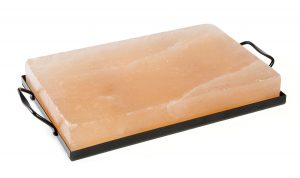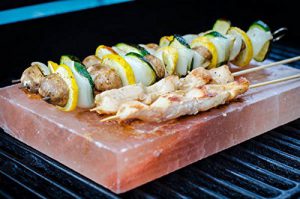Himalayan Salt Block Cooking – Ancient Flavour At Home
What is Salt Block Cooking? Himalayan Salt Blocks, Slabs, Bricks or Pink Salt Blocks, as they are referred to sometimes, are an Ancient Salt Stone that are harvested from deep within the Himalayan mountain range of Pakistan. Crystallised more than 250+ million years ago during the Jurassic Era, Ancient volcanic lava covered sea beds, protected the salt crystals from pollution and impurities for these millions of years creating a belief that the Himalayan Pink Salt is the purest untarnished salt, and rich in many trace elements to be found on Earth.

The various pink coloured salt stones are carved out of the mountain caves and cut into various sizes, thicknesses and shapes for not only cooking on but also to be used as perfect gourmet platters and even turned into exotic decorative naturally shaped Pink Salt Lamps. The Himalayan Salt Blocks can be chilled or frozen and used for serving cold foods like fruits, cheese, desserts or ice-cream. While the foods are displayed they absorb some of the natural ancient salt and minerals giving a unique flavoursome taste and also an artful display piece and entertainment talking topic. Apart from these attributes, I will be describing and explaining how to use Himalayan Salt Blocks for cooking meats on for an outstanding flavoursome and taste experience.
Right, how to get started…
1 Pick your Himalayan Salt Cooking Block
I suggest that you chose a nice sized block 12 x 8 x 2 inches or 12 x 8 x 1.5 inches as these are a perfect size for heating and also larger enough for cooking a nice amount of meat. There are various sizes and shapes but you really need a salt block with enough room for cooking enough meat. See what I recommend here from Amazon. They have a good selection with many varying prices as well.
2 Heat up your Himalayan Salt Block slowly
Make sure that the salt block is completely dry and for the first few times when heating a new block fissures or cracks may appear. The colour may also change to whiter but this normal. After a few uses the block will return to its shade of pink. IMPORTANT…DO NOT SOAK THE SALT BLOCK IN WATER TO CLEAN I will get to the care of your Himalayan Salt Block a little further down the page.
The golden rule for heating any salt block is to heat it SLOWLY…
- 15 to 20 minutes on low heat first,
- 15 to 20 minutes on medium heat then
- 15 to 20 minutes on high heat
To check that it’s hot enough you can use a water sprinkle test. Just sprinkle a few drops of water onto the salt block and if they sizzle and disappear quickly then the cooking surface is ready. Alternatively you can just place your hands a few inches above the block and if you can’t hold it there for 5 seconds then your ready to go.
Now for a little more info on the heating by Gas, Electric, BBQ Grill and Oven…
Gas Element
Very easy, just place the salt block directly onto the element and heat up as described above. Increase the heat from low to low medium to medium high. If you wish for quick sauteing then heat the block for an extra 5 minutes but normally it should be hot enough.

Electric Element
Just as easy except we need an added a tool to keep the salt block off the actual element surface. All you need is a circular metal ring to separate the block from the element surface. Simple as a wok ring, pastry ring or even a pop out cake tart ring. We need to leave a gap between the block and the element to heat the block effectively. Once set up just heat as for a gas element.
BBQ Grill
Just as easy. Use the grate on the BBQ and ensure the it is well cleaned. If using a gas BBQ then follow the steps just like using a gas element. If using charcoal, move the charcoal to one side of the BBQ and place the salt block on the opposite side. We don’t want the block exposed to direct heat. Use the sprinkle water technique to check is the block is ready after sufficient time.

Oven
Heating the salt block in an oven is not really advisable as it may damage your oven and block. It is however a unique way of baking or roasting meat. Best thing is too heat the salt block with any of the above methods and then place the salt block onto the rack into a preheated oven and your ready to bake.
3 Cooking your steaks
Okay then, you are ready to cook. You can just place your steak directly onto the heated block or you can rub a little olive oil over the steak and then place onto the block. The oil will help reduce the salt absorption a little. The moisture in foods that you wish to cook on the block will pick up the salt, while fat and oils will repel the salt. No need to season as the cooking process will allow the steak to absorb the salt and minerals from the salt block. Using smaller pieces of meat will obviously cook quicker and if the block hasn’t been heat up enough the foods will become saltier and also the block will wear out faster.
To turn the steak over use a metal spatula or metal tongs. Do not use plastic tools as they may melt and ruin your Himalayan Salt Block.
Cooking Time
- 1 to 2 minutes per side for thin steaks
- 5 to 7 minutes per side for thicker steaks
Use your better judgement and use the OK method to cook your steaks to your likeness. You can check here for that tip.
Leave the salt block where you are heating and continue to cook your steaks or foods until you’ve finished or once heated, move the block onto a wooden cutting board just like a cast iron sizzling plate and cook your foods on the table where you eat. There are Himalayan Salt Block holders that you can use to make carrying and moving easier. You will always need to wear good quality oven gloves to avoid getting burnt when handling the heated block. After all the blocks are heated to 500 degrees F/260 degrees C approximately.
4 Cooling, cleaning and storing your Himalayan Salt Block
Turn off your heating source and leave the block to cool. This could take an hour or so. The block must be cool to touch.
When the block is cool moisten the block with a damp sponge or cleaning cloth …IMPORTANT DO NOT USE SOAP...scrub the block with a soft brush or sponge scourer and remove any food particles that may be stuck. Wipe clean with a cloth or sponge and repeat process until all cooked on food particles are removed. Use as little water as possible and keep the block as dry as possible. Towel dry to make sure the block is free from water.
The reason why we don’t need soap or detergent to clean our salt block is, the salt has powerful antimicrobial properties that keep the block ready for future use.
Store in an area where there is little humidity and ventilated if possible. If you live where the humidity can be high, wrap the cleaned block in a cloth or towel and store in a kitchen cupboard.
There are countless recipes that can be used with a Himalayan Salt Block. I recommend Mark Bittermans Salt Block Cooking recipe book, that has sold over 100,000 copies. I am sure you wont be disappointed. Click the book to purchase from Amazon.
After many uses of your Himalayan Salt Block the block will wear and misshapen and even form cracks and fissures. Don’t despair even if your block breaks. It is a solid piece of salt that you can use. Just grab a grater and grate the pink salt over your food. Even grind it down in a Pestle and Mortar and viola, you have made your own Ancient Pink Salt.
I hope you have enjoyed my description of Himalayan Salt Block Cooking. Leave a comment or tell me about your experiences with salt blocks and feel free to ask any questions. I am here to help you enjoy your meat eating experience…
John

So I have used himalayan salt for cooking, as in adding a bit to steak but never to cook on, due to its health benefits. How many times can you cook on? Is it easy to acquire? I have never seen this before but it is certainly something I will look at acquiring.
Hi and thanks for visiting my website. Yes the Himalayan Salt Block is a unique tool for giving your meat great taste and flavour enhancement. The number of times that you can cook on really depends on how well you take care of it and how many times you actually use it. As it is of natural material the blocks will wear down and can have fissures and cracks on the inside that you can’t see and with heating they can occur and broaden. Some people have reported that they have used their blocks for over a year and dozens of times. But don’t worry if it does crack or break you can still use the salt by grating over your foods. Great to add a bit to ice cream as well. You can find my recommendation here at Amazon with other selections if you wish to browse the store. Thanks again and if you try it out let me know how you go. John
Good post. I learn something new and challenging on sites I StumbleUpon every
day. It’s always helpful to read through articles from other writers and practice a
little something from other websites.
Thanks for visiting my site and your comment. I checked out your website and some great products you have.
good and informative post. i have tried himalayan salt block for cooking and that food have different and good taste.
cooking on himalayan salt blocks is a unique and trending method. food become more delicious. your article is more informative then others thanks for sharing with us. himalayan salt blocks wholesale
By cooking on a Himalayan salt block, your food will be infused with the 80+ minerals found in the salt. Not only are these healthy, they will also impart a more complex flavour profile to your food.
Really enjoyed this breakdown! Himalayan salt block cooking is such a cool way to bring natural mineral flavor into everyday meals without extra seasoning. I love how it gives a light salty crust on things like grilled veggies and steaks while also being a fun experience at the table.
If anyone’s exploring different culinary salts for finishing or seasoning alongside salt block cooking, I’ve had great results using Himalayan salt
— adds just the right touch.
Thanks for the tips and inspiration!